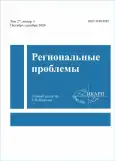Korean immigrants in the history of the Jewish Autonomous Region
- Авторлар: Gurevich V.S.1
-
Мекемелер:
- Институт комплексного анализа региональных проблем ДВО РАН
- Шығарылым: Том 27, № 4 (2024)
- Беттер: 117-122
- Бөлім: History
- URL: https://journal-vniispk.ru/1605-220X/article/view/284540
- ID: 284540
Дәйексөз келтіру
Толық мәтін
Аннотация
The successful Amur rafting and signing of the Aigun and Beijing treaties with the Qing Empire ensured the Russian Far Eastern lands return in the middle of the XIX century. Subsequently, more than a dozen new settlements appeared on the left bank of the Amur River, including the future Jewish Autonomous region area. Some of them were founded by Koreans, whose exodus to Russia began in 1864. At the same time, Koreans voluntarily changed their religion from Buddhism to Orthodoxy. Because of the lack of land plots for them in the south of Primorye, the Russian government allowed the new Russians to partially relocate to other areas in the Far East, including the Amur lands. About five hundred people settled on the lands assigned to them by the Catherine-Nikolsky Cossack district at the confluence of the Samara River with the Amur. Here, in 1871, they founded their settlement. One of their villages, formed in 1871, was the village of Blagoslavennoye, named by the Koreans themselves in honor of the Christian blessing.
Subsequently, Korean settlements appeared at In station, the village of Tikhonkaya. There were small Korean schools opening there. Korean peasants more than enough provided the regional markets with vegetables and other agricultural products. The black days in the history of the Korean inhabitants of the Far East came in September 1937, when the Korean population was resettled in Kazakhstan.
Негізгі сөздер
Авторлар туралы
V. Gurevich
Институт комплексного анализа региональных проблем ДВО РАН
Хат алмасуға жауапты Автор.
Email: gurevichv.48@mail.ru
ORCID iD: 0009-0005-1512-1459
Ресей, ул. Шолом-Алейхема 4, г. Биробиджан, 679016
Әдебиет тізімі
- Administrativno-territorial’noe ustroistvo Evreiskoi avtonomnoi oblasti. 1858-2003 gg. (The administrative and territorial structure of the Jewish Autonomous Region. 1858-2003). Khabarovsk: RIOTIP Publ., 2004. 352 p. (In Russ.).
- Birobidzhanskaya zvezda, 2006, august 17th, no. 58. (In Russ.).
- Blagoslovennoe in destinies and photographs. Birobidzhanskaya zvezda, 2015, september 23rd, no. 67. (In Russ.).
- Vaiserman D. Birobidzhan: mechty i tragedii. Istoriya EAO v sud’bakh i dokumentakh (Birobidzhan: Dreams and tragedies. The history of the EAO in the fates and documents). Khabarovsk: RIOTIP Publ., 1999. 512 p. (In Russ.).
- GA EAO. F. I-490. Op. 1. D. 20. L. 237–252. (In Russ.).
- GA EAO. F. R-186. Op. 2. D. 1. L. 100. (In Russ.).
- Kazakevich E. Birobidzhanstroi: sbornik stikhov na idish i v perevode na russkii yazyk (Birobidzhanstroy: collection of poems in Yiddish and translated into Russian), V.S. Gurevicha Ed. Birobidzhan, 2016. 119 p. (In Russ.).
- Tal’mi L. In Korean. Urmi. A chapter from the book «On virgin land». (Translated from Yiddish by E. Sarashevskaya), in Lyudi birobidzhanskogo pokoleniya (People of the Birobidzhan generation), E.I. Sarashevskaya Comp. Birobidzhan, 2019, kn. 2, pp. 85–94. (In Russ.).
- Three schools of the Korean village. Birobidzhaner shtern, 2011, july 6, no. 47. (In Russ.).
- Khashchevatskii M. A raize kein Birobidzhan («Puteshestvie v Birobidzhan»): kniga ocherkov (A raise kane Birobidzhan («Journey to Birobidzhan»): the book of essays), V. Fomenko translated from Yiddish. Kiev, 1937. Available at: http://nasledie-eao.ru/news/pdf (accessed: 12.03.2024). (In Russ.).
Қосымша файлдар









